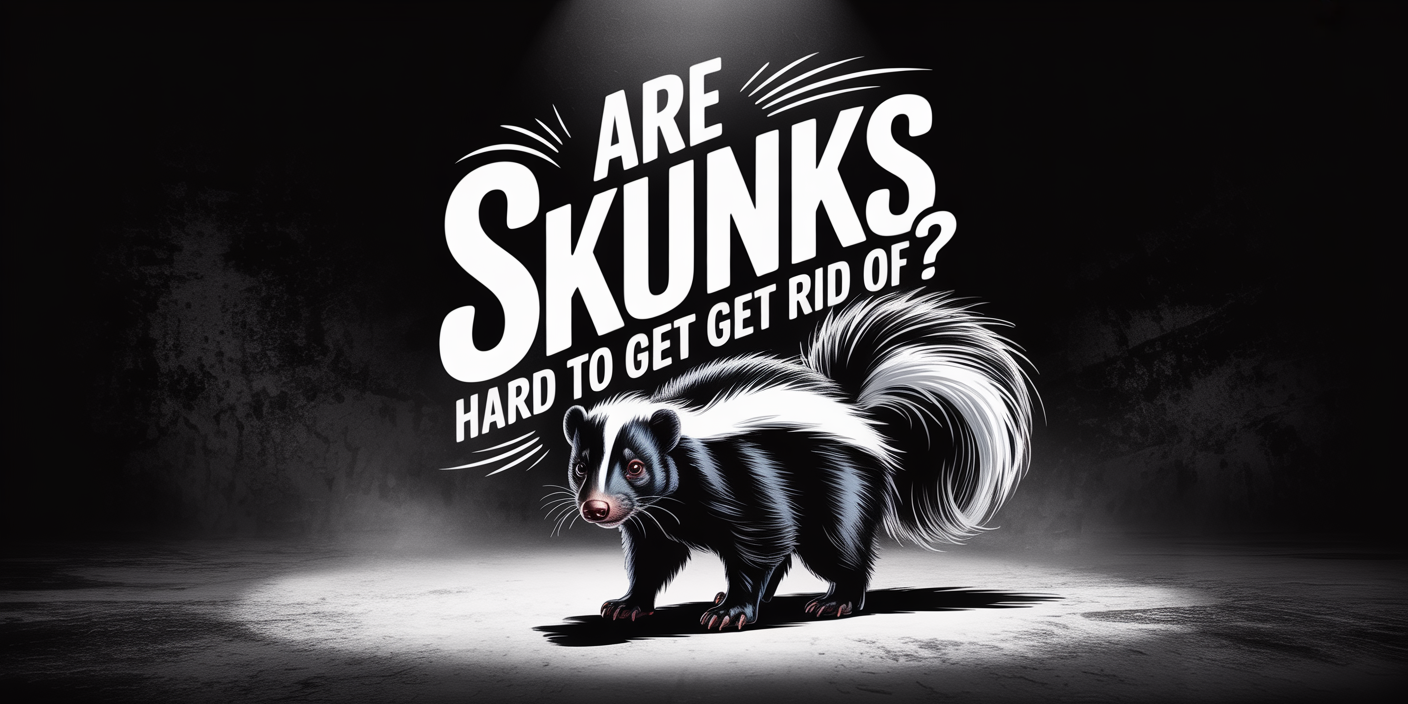Yes, skunks are hard to get rid of because they’re stealthy, legally protected, and likely to spray if threatened. Their dens are tough to reach, and most DIY methods either fail or make the situation worse. Removing them takes more than repellents—it takes strategy, timing, and often, professional help.
At first glance, skunks seem like slow-moving, stinky squatters you can just shoo away with a broom. Reality check? Once they settle in, removing them is a whole different story. Skunks are far more stubborn, sneaky, and legally protected than most homeowners realize, especially compared to your average pest—and one wrong move could leave your property smelling like regret for weeks.
So, are skunks hard to get rid of? Absolutely. Not because they’re invincible, but because everything about their behavior, biology, and legal status makes removal trickier than you’d think. That’s where AAAC Wildlife Control steps in—bringing expertise, equipment, and a proven process to do what DIY can’t.
Why It’s So Hard to Get Rid of Skunks Once They Move In
Skunks aren’t just passing through your property like raccoons on a snack run. Once they take up residence, they dig deep—literally—and use every instinct they’ve got to stay hidden, protected, and impossible to chase off. That’s what makes removal more of a tactical operation than a quick fix.
They’re Stealthy, Nocturnal, and Excellent at Hiding
Skunks do their digging, scavenging, and exploring when you’re fast asleep. You rarely see them directly, which means by the time you notice the smell or the torn-up lawn, they’ve already built a comfortable den somewhere on your property. And because they don’t make much noise, weeks can pass before the damage becomes obvious.
Their Dens Are Hard to Reach and Easy to Miss
Skunks love tight, sheltered spaces—under your deck, shed, or porch. These spots are difficult to inspect without crawling around in awkward, confined spaces—exactly the kind of territory that lets a pest like a skunk thrive unnoticed, which is exactly what they’re counting on. Even if you find the entry point, disturbing it without proper tools or protective gear can lead to worse problems than you started with.
They Come Fully Armed with Their Own Security System
This is the part everyone fears for good reason. When threatened, skunks don’t bluff. They don’t bluff. One wrong move can trigger their infamous musk—and that stench clings to everything from furniture to clothing. The smell isn’t just foul—it’s hard to remove from porous surfaces, pets, and even HVAC systems.
They Don’t Give Up Easily
Even if you manage to remove the skunks temporarily, this pest often returns if the conditions still feel just right, it may return to the same den if the conditions are still ideal. Worse, skunks are known to pass off dens to other animals, including rodents and raccoons, turning one invader into a rotating cast of new problems. The longer they stay, the more invested they become in your property—and the harder it gets to evict them without a serious plan. If your yard still offers shelter or a reliable food source, they’ll find every excuse to return.
Why Most Skunk Infestations Aren’t Obvious Until It’s Too Late
Skunks don’t kick down the door and announce themselves—they slip in quietly, settle deep underground, and leave clues so subtle you’ll miss them unless you know what to look for. That’s what makes early detection so tricky. By the time you catch a whiff of trouble, the infestation may already be layered in.
Here’s what to watch for:
- Faint but growing odor: The classic skunk spray isn’t always immediate. A skunk may spray underground or near vents, leaving a low, musty smell that lingers for days before it hits full-blast, especially if they’ve sprayed underground or near crawl spaces.
- Conical holes in the yard: Skunks dig while foraging for grubs and insects, often leaving small cone-shaped holes in lawns and gardens. Unlike gophers, their digging is shallow and widespread.
- Burrow openings under structures: Gaps under decks, sheds, and porches may be entry points to a den. If the hole is 4–6 inches wide and smells faintly musky, it’s likely more than just a random dig.
- Nighttime noises or activity: Rustling, scratching, or thuds after dark could mean a skunk is up and about. They’re solitary and quiet—but not silent.
- Pet behavior changes: Dogs and cats may act agitated, sniff around one spot obsessively, or bark at corners of the yard with no visible threat. Animals often sense skunks before you do.
Spotting these signs early makes a huge difference. If left unchecked, a single skunk can turn into multiple visitors, damage your yard, and make removal ten times more complicated. That’s why a professional inspection from AAAC Wildlife Removal often uncovers problems homeowners didn’t even realize they had.
Tried Every Pest Trick and the Skunk’s Still There? What Most People Do First
It’s totally fair to want to handle a wildlife issue on your own before bringing in a pro. That said, skunks are not raccoons, squirrels, or mice. Their defense mechanism alone raises the stakes, and most DIY tactics either fall short or backfire entirely. Still, if you’re determined to try, here’s what you can do—along with why each method only goes so far.
1. Skunk Repellents and Deterrents: Why They Rarely Work on Skunks
Motion-activated lights, radios, store-bought repellent sprays, or ammonia-soaked rags are popular DIY tactics because they’re easy to set up. The theory is simple: make the environment uncomfortable and the skunk will leave. These deterrents aim to repel the animal, not confront it—but skunks aren’t easily rattled. The problem? Skunks get used to patterns fast. Once they realize there’s no real threat, they stay put or shift their activity to a quieter corner of your yard.
2. Seal Off Den Sites Around Your Property to Prevent Skunk Problems
Sealing entry points is smart in theory—just not while the skunk is still inside. Closing off a burrow without confirming it’s empty can trap the animal, create panic, and trigger a spray incident right under your home. Timing matters, and unless you’ve got the right tools and experience, it’s easy to make things worse before they get better.
3. Live Traps (Proceed With Caution)
Yes, skunks can be trapped humanely, but pulling that off without getting splashed requires more than a YouTube tutorial. Skunks are unpredictable when confined, and one startled move is enough to get sprayed from less than two feet away. Even if you manage to trap one successfully, local laws may prohibit releasing it elsewhere without a license or permit. And if you mishandle the animal or get too close, there’s a small but serious risk of rabies exposure—which turns a DIY attempt into a potential health scare.
4. Why Calling AAAC to Remove Skunks Is the Smarter Move
When it comes to skunks, there’s only so much you can DIY before the risk outweighs the reward. Unlike standard pest control, this isn’t about spraying and walking away. Professional Removal skips the guesswork and goes straight to a humane, no-spray process that actually works. From thermal inspections to targeted trapping, our team knows how to outsmart skunks without triggering a standoff in your backyard.
We don’t just remove the skunk—we find how and why it got there in the first place. Every job includes habitat modification, entry-point sealing, and professional-grade odor control so your home doesn’t become a repeat target. If the skunk is gone but the scent isn’t, your problem isn’t solved—and we know how to finish the job completely.
It’s not about chasing skunks away. It’s about making sure they don’t come back.
Beyond Repellents: How to Truly Keep Them Away
Deterring a skunk is one thing. Finding ways to keep them away long-term is the real win. Skunks are opportunists, and if your property still offers food, shelter, or easy access, chances are high they—or something worse—will return.
Prevention isn’t complicated, but it does take consistency. Secure garbage bins tightly. Clear out brush piles, wood stacks, leftover pet food, fallen fruit, and clean around any outdoor feeder to eliminate food trails that attract rodents or skunks, and avoid relying solely on repellent sprays they quickly adapt to. Install barriers around decks and sheds so there’s no cozy crawlspace for future tenants. A little maintenance now saves you a massive headache later.
Still, the best prevention is knowing your property inside and out. That’s why AAAC Wildlife Removal doesn’t just handle eviction—we help you skunk-proof your space with permanent solutions. Because once you’ve had a skunk, you’ll never want to go through it again.




